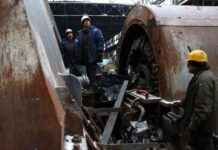Idyllic motorways are rare. The bands of concrete and asphalt seem to run endlessly through the landscape, with almost always at least seven, often nine or more lanes including the hard shoulder and the median. Crash barriers and blue signs draw attention to themselves.
On the other hand, route 46 between Gemünden am Main and Bad Brueckenau is very idyllic; right where the Spessart meets the Rhön. Because this route, almost 70 kilometers long, was never completed. To date, 47 buildings, mostly bridges and pillars, have survived in the landscape; moreover, one can follow the already heaped up earth for kilometers for the planned motorway. She never got an asphalt surface; that is what makes this remnant so appealing.
Route 46 was part of the Reichsautobahn network planned in 1934. It was supposed to connect Würzburg with Fulda and, as one of three north-south lines in the geographic center of Germany, relieve the already well-advanced connection Mannheim-Frankfurt-Kassel in the west as well as the Nuremberg-Bamberg-Suhl line that was only planned.
In accordance with the route, which was always ideologically motivated under National Socialism (the Reich autobahns were considered the “roads of the Führer” in propaganda), the route lay between Spessart and Rhön. It was also planned in such a way that the southern section had a view of the Homburg ruins, the second largest German castle complex. Such visual axes were popular with Nazi functionaries – just think of the orientation of the “Great Street” of the NSDAP Nazi Party Rally Grounds towards the Imperial Castle in the old imperial city of Nuremberg.
A little more than 30 kilometers in length, the embankment was already built as a bank. Larger parts of it can still be made out today on aerial and satellite images from Google Earth, for example; mostly due to more or less strongly deviating trees compared to the surrounding woods or fields.
There are numerous remains on the ground. Among them are several drainage systems made of concrete with neatly joined round arches, often made of locally cut stones in the middle of the (today’s) forest, underpasses that have never been used (e.g. for a connection between the villages of Burgsinn and Gräfendorf) and a pillar for the overpass of the line over the Franconian Saale Schonderfeld.
Incidentally, between 1937 and 1939, many guest workers from the former Czechoslovak Republic worked on route 46 – because German men had become rare because they were successively drafted for military service from 1935. In October 1939, the construction work was terminated for seasonal reasons and not resumed in spring 1940 due to the war.
After 1945, the decision was made not to use the preparatory work on route 46 to expand the network of federal autobahns; instead, the new Autobahn 7 was rebuilt about 20 kilometers to the east. There were three main reasons for this: First, the route had 46 gradients of up to 6.25 percent, but the new network of federal motorways had set a maximum value of four percent.
Secondly, the pre-war road did not correspond to the new traffic task, because it ran too far west of the zone border now to be taken into account and ran past the northern Bavarian industrial areas. Thirdly, the ideological motifs from the Nazi era no longer played a role – views of castles were now simply irrelevant.
For this reason, Federal Transport Minister Hans-Christoph Seebohm decided in 1960 not to continue building route 46. Hitler’s Spessart route was no longer good enough for a modern long-distance road network. The remains have been rotting away ever since. Since 2003 they have been under monument protection; there are also active associations and individuals who offer guided tours.
You can also find “World History” on Facebook. We are happy about a like.
This article was first published in November 2019.








